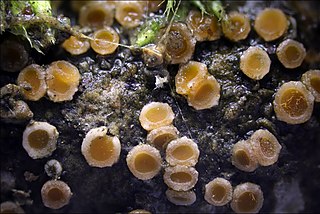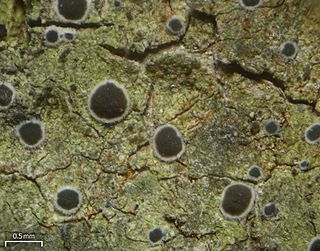
Gyalectales is an order of lichen-forming fungi in the class Lecanoromycetes. It contains 5 families, 18 genera and about 550 species.

Porinaceae is a family of lichen-forming fungi in the order Gyalectales. While Trichotheliaceae was proposed as an alternative, Porinaceae is the widely accepted name following ongoing nomenclatural discussions. Most members of this family typically have a crust-like appearance and grow on a variety of surfaces, including tree bark, leaves, and rocks. Porinaceae is known for its diverse morphology, ranging from simple crust-like forms to more complex structures with distinct lobes or fan-shaped scales. Porinaceae species generate small, typically flask-shaped reproductive structures, which house spores essential for reproduction. It includes nine recognised genera and more than 365 species, with significant diversity in tropical and subtropical regions.

Porina is a genus of crustose lichens in the family Porinaceae. As of August 2024, Species Fungorum accepts 161 species of Porina.

Byssoloma is a genus of leaf-dwelling lichens in the family Pilocarpaceae.
Gallaicolichen is a fungal genus that contains the single species Gallaicolichen pacificus, a foliicolous (leaf-dwelling) lichen. Originally discovered in Hawaii in 2007, G. pacificus has since been found in various locations across the Pacific, including Australia, New Caledonia, Vanuatu, the Philippines, and Japan. The lichen forms small, pale greenish-yellow to yellowish-grey patches on leaves, typically in mid-altitude forests and along forest edges. G. pacificus is notable for its unique reproductive structures called peltidiangia, which produce disc-shaped propagules (peltidia) for asexual reproduction. Initially, its taxonomic classification was uncertain, but recent discoveries of specimens with sexual reproductive structures have enabled scientists to confidently place it within the family Porinaceae.
Graphis marusae is a species of corticolous (bark-dwelling) crustose lichen in the family Graphidaceae. It is found in a relict tropical lowland rainforest in Veracruz, Mexico, growing in exposed understory.

Malmidea is a genus of crustose lichens and the type genus of the family Malmideaceae. It was established in 2011 to contain a phylogenetically distinct group of species formerly placed in the genus Malcolmiella. The crust-like thallus of Malmidea lichens has a surface that varies from smooth to rough, featuring textures such as verrucose (wart-like), granulose (grainy), or pustulate (pimpled). These textures are often formed by goniocysts, which are spherical clusters of green algal cells from the family Chlorococcaceae, encased in fungal hyphae. Malmidea comprises nearly 70 mostly tropical species that grow on bark, although a few grow on leaves.
Clypeopyrenis porinoides is a species of corticolous (bark-dwelling) lichen in the family Pyrenulaceae. Found in Costa Rica, where it grows primarily on tree trunks and the understory of primary forests, it was described as new to science in 2011. Closely resembling some Porina species, this lichen is characterised by its light greyish-green surface and distinctive perithecia that set it apart from its close relative, Clypeopyrenis microsperma.
Porina linearispora is a species of corticolous (bark-dwelling) lichen in the family Porinaceae. Found in Brazil, it was formally described as a new species in 2013 by lichenologists André Aptroot and Marcela Cáceres. The type specimen was collected by the authors from the Parque Natural Municipal de Porto Velho, where it was found growing on bark in a primary rainforest. The lichen is distinguished from other members of genus Porina by its long and thin ascospores, for which the species is named.
Trichothelium angustisporum is a species of corticolous (bark-dwelling), crustose lichen in the family Porinaceae. It is found in subtropical regions of Guyana and the Atlantic Forest of Brazil. The lichen was formally described as a new species in 2004 by lichenologists Marcela Eugenia da Silva Cáceres and Robert Lücking. The species epithet refers to its narrow and elongated ascospores.
Fissurina amyloidea is a little-known species of script lichen in the family Graphidaceae. It is found in the primary rainforests of Rondônia, Brazil. It is characterized by its weakly carbonizedlirellae and thick-walled, strongly amyloid ascospores. Despite its superficial similarity to Fissurina subfurfuracea, F. amyloidea exhibits unique anatomical features that set it apart from other species within the genus.
Fissurina chrysocarpa is a little-known species of script lichen in the family Graphidaceae. Found primarily in the rainforests of Rondônia, Brazil, it is distinguished by its bright orange lirellae.
Porina monilisidiata is a species of corticolous (bark-dwelling), crustose lichen in the family Porinaceae, first described in 2016. This species is characterised by its shiny, olive-green thallus with numerous isidia and low conical ascomata.
Porina microtriseptata is a species of corticolous, crustose lichen in the family Porinaceae, first described in 2016. This species is distinguished by its shiny, olive-green thallus and hemispherical ascomata with pointed ascospores that are consistently hyaline, fusiform, and have three internal partitions (septa).
Byssotrema is a monotypic fungal genus in the subfamily Graphidoideae of the family Graphidaceae. It contains the single species Byssotrema mirabile, a little-known corticolous (bark-dwelling), crustose lichen found only in Brazil.
Corticorygma is a monotypic fungal genus in the subfamily Graphidoideae of the family Graphidaceae. It contains a single species, the corticolous (bark-dwelling) crustose lichen Corticorygma stellatum. This script lichen is found in the shaded understory of rainforests in the Brazilian states of Rondônia and Paraná.
Porina boliviana is a species of foliicolous (leaf-dwelling) crustose lichen in the family Porinaceae. It was formally described as a new species in 2008 by the lichenologists Adam Flakus and Robert Lücking. They named it after the country where it was discovered, Bolivia. Flakus collected the type specimen from Nuevos Reyes village in the José Ballivián Province, where he found it growing on palm tree leaves in a lowland Amazon forest.
Trichothelium subargenteum is a species of foliicolous (leaf-dwelling) crustose lichen in the family Porinaceae. Found in Bolivia, it was scientifically described in 2008 by the lichenologists Adam Flakus and Robert Lücking. The specific epithet subargenteum refers to its similarity to another species, T. argenteum, which has been found in Costa Rica and Argentina.

Saxiloba is a genus of lichen-forming fungi in the family Porinaceae. It comprises three species of saxicolous (rock-dwelling) placodioid lichens, known from disjunct locations in the Caribbean, Hawaii, and Brazil. The genus was circumscribed in 2020 to accommodate species with a distinctive placodioid thallus featuring unique surface patterns and internal crystal structures. Saxiloba lichens are characterised by their flattened, leaf-like thalli with marginal lobes, growing tightly appressed to rock surfaces. They have a complex internal structure, including large crystal clusters embedded within the photobiont layer, which may be an adaptation for light management in their typically shaded habitats.





